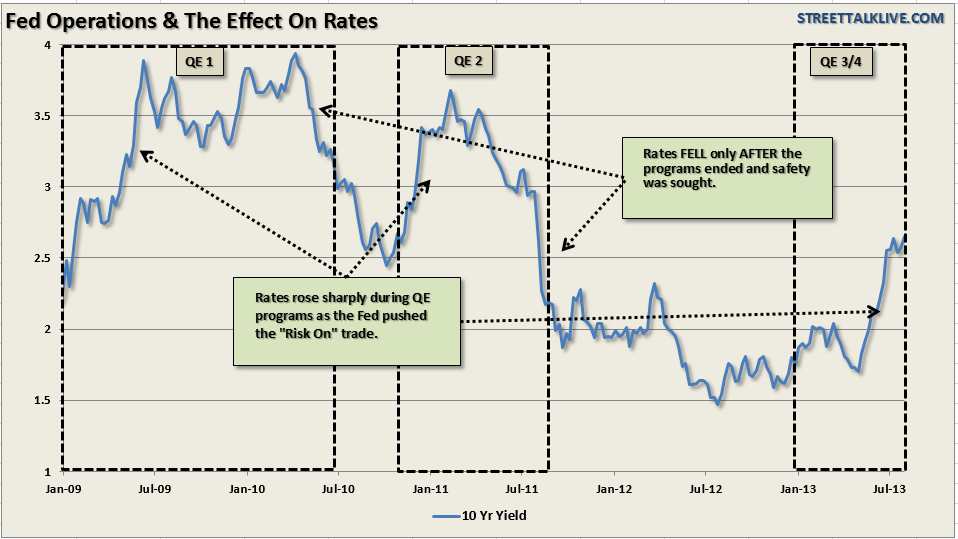The Impact of Rising Interest Rates
Post on: 11 Август, 2015 No Comment

The Impact of Rising Interest Rates
Jim Gilliland, CFA
President & CEO, Head of Fixed Income
With the recent rise in interest rates, investors are becoming concerned about a number of things — in particular, the bond portion of their portfolios. That’s because bond prices have an inverse relationship to interest rates, they drop when interest rates rise.
Yet bonds aren’t the only kinds of securities to suffer amid the spectre of rising rates.
Other vulnerable securities include so-called fixed-income “surrogates” like preferred shares and high dividend-paying stocks. They’re called surrogates because by paying dividends they offer the regular income that bonds do — and that many investors love and rely on.
In our historically low interest-rate environment, investors seeking income have flocked to these surrogates, driving their prices up and pushing many to record high valuations. So, in their quest for income security, investors have unfortunately been paying a high price that could lead to capital losses when the securities are eventually sold.
Interest rates have been at historic lows for the past several years, mainly due to quantitative easing, the U.S. government’s bond-buying program designed to support its economy. Recently, rates were driven higher by comments made by the U.S. Federal Reserve in which it outlined a formal exit strategy for this unprecedented monetary stimulus.
But what is important for investors to note is that rate increases are not imminent, nor are we expecting to see a drastic spike in rates. Increases are likely two to three years away, based on our analysis of economic conditions in the U.S. and how they will affect the tapering of quantitative easing. When increases arrive, they’ll likely be gradual.
Here are some key points to bear in mind about fixed-income surrogates:
1. Bonds will always play a critical role in portfolios because of the diversification benefits they offer. However, while interest-rate increases are inevitable, investors should not panic and sell their bonds without fully understanding their characteristics. What might be surprising is how the pace of rising interest rates will affect your portfolio. Because long-term bonds move in the opposite direction of equity markets, they can hold up the value of an overall portfolio when stock prices hit a rough patch.
2. So how about preferred shares? Not all are created equal. Different categories of preferred shares will have different interest-rate sensitivities.
• Perpetual Preferred Shares will be most sensitive to rising interest rates. These generally have no maturity date and will pay a fixed dividend for as long as they exist. With no maturity date, these types of preferred shares will have a long duration and have interest rate sensitivities similar to a long-term government bond.
• Step-Up Preferred Shares or Rate Reset Preferred Shares pay a fixed dividend for a specific period of time (generally five years). At the rate reset date, the issuer can buy back the preferred share by paying the investor the redemption price. These types of preferred shares will have lower interest rate sensitivity — they’ll behave more like a short-term corporate bond.
• Floating Rate Preferred Shares pay a dividend that floats or changes with the interest rates. This type of preferred share will exhibit minimal sensitivity to rising interest rates as the investor has the certainty of an increasing cash flow as interest rates rise. Over the last several months, we have seen floating-rate and step-up preferred shares hold their value during a time in which perpetual preferred shares have declined significantly.

3. And how about high-dividend paying equities? Let’s go back to 1994, considered one of the worst bond market years in recent history. Interest rates on 10-year government bonds rose from 6.6 per cent yields to 9.1 per cent yields over the course of the year. Overall, the stock market, as measured by the S&P 500, was flat, with an annual return of just 1.3 per cent.
However, some sectors fared better than others. Technology and materials stocks (more economically sensitive) delivered whopping returns of 19 per cent and 12 per cent respectively. Prices of more interest-sensitive stocks such as telecommunication companies were down close to 13 per cent and utilities were down by more than 22 per cent.
In any type of investment portfolio, mitigating losses from interest rate increases requires looking beyond just your bond portfolio. Look at your preferred shares and high dividend paying equities, too. Rising rates can also be a positive for short term investments such as money market funds which are currently offering yields that are lower than inflation.
For clients wanting reasonable income and less interest-rate risk, they might consider an income model that combines higher quality, short-term corporate bonds with step-up preferred shares.
For equities, we suggest focusing on reasonably valued stocks and tend to favour lower yielding stocks that can provide dividend growth rather than the highest yielding stocks that may have unsustainable payout ratios.
For clients looking for diversification and some degree of equity risk offset, we suggest still retaining some exposure to 10- to 30-year government bonds but minimizing the interest rate sensitivity in preferred stock and equity portfolios.
This article is not intended to provide advice, recommendations or offers to buy or sell any product or service. All tax decisions should be made after discussing your individual positioning with a qualified tax accountant, as everyone’s tax situation is unique. The information provided in this report is compiled from our own research and is based on assumptions that we believe to be reasonable and accurate at the time the report was written, but is subject to change without notice.
By Leith Wheeler August 27, 2013














